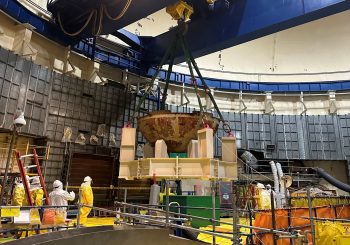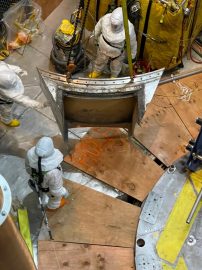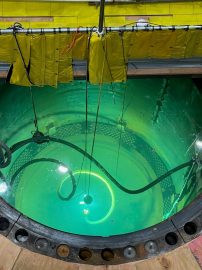Crews complete major reactor vessel work at Fort Calhoun Station

OPPD crews achieved a significant milestone last week in the decommissioning of Fort Calhoun Station (FCS) when crews finished cutting the station’s reactor vessel into segments.
The reactor vessel was the most significant component remaining on site, from a radiological standpoint. The segments were shipped out of state to a waste disposal site.

The milestone was the culmination of a year’s worth of preparation and work.
“The reactor vessel’s removal allows us to start removing all the other components from containment,” said Tim Uehling, senior director of FCS Decommissioning.
Workers used an oxy-propane torch to cut the reactor into 43 pieces over two months, said Ted Maine, plant manager of Decommissioning at FCS. Those pieces varied in weight from 6,000 to 40,000 pounds.
“In terms of radiological risk, this takes us down another notch,” Maine said. “It is a big relief to have this done and to have done it safely.”
The past 12 months marked the best year for safety at FCS, Maine said.
The size of the reactor vessel provides perspective for the segmentation project. The reactor vessel weighs more than 500,000 pounds. It is about 32 feet tall and 14 feet wide and made of 7- to 10-inch thick carbon steel.
The number of materials that have absorbed radiation has continued to drop since crews moved the last canister of spent nuclear fuel to its dry cask storage in May 2020. Completing each project lowers the amount of radiated tools, systems, and infrastructure at the site, Uehling said.
Other accomplishments
Other smaller but still noteworthy projects completed in 2023 include:
- Removal of the intake structure. The intake structure brought Missouri River water into the plant for cooling. That structure’s intake and discharge tunnels were filled with grout and soil.
- Demolition and removal of the administration building.
The last big project for the year centers on the reactor vessel’s hemispherical bottom head or lower bowl. The lower bowl weighs approximately 80,000 pounds and has been removed from containment; crews will finish the work of having it removed from the site by the end of December.
Looking ahead

FCS officials expect 2024 to be another busy year. Plans call for removing the two steam generators, the main reactor cooling pumps, and the plant’s pressurizer. The pressurizer in a nuclear plant keeps water from boiling when a plant is operating.
Crews will remove the remainder of the internal parts in the containment building throughout 2024 and into 2025. Those parts will also be shipped out of state to a waste disposal site.
By next year, crews will have removed 90% of radioactive materials from the site, Maine said. Radiology operators perform daily surveys and tests on the 600-acre site. The area is mapped into grids using GPS by radiological surveyors. The containment building will be demolished and removed in 2025. FCS remains on track to reach greenfield status in 2026. Greenfield status means virtually no trace of the plant will remain.
The dry cask storage facility and the training center will remain on site for the foreseeable future.
The plant ceased operations in 2016 due to economic necessity and significant shifts in the energy industry. FCS first came online in 1973.

Jason Kuiper joined OPPD as a communications specialist in 2015. He is a former staff writer and reporter at the Omaha World-Herald, where he covered a wide range of topics but spent the majority of his career covering crime. He is a graduate of the University of Nebraska at Omaha and has also appeared in several true crime documentary shows. In his free time he enjoys cooking, spending time with his wife and three children, and reading crime novels.
View all posts by Jason Kuiper >







